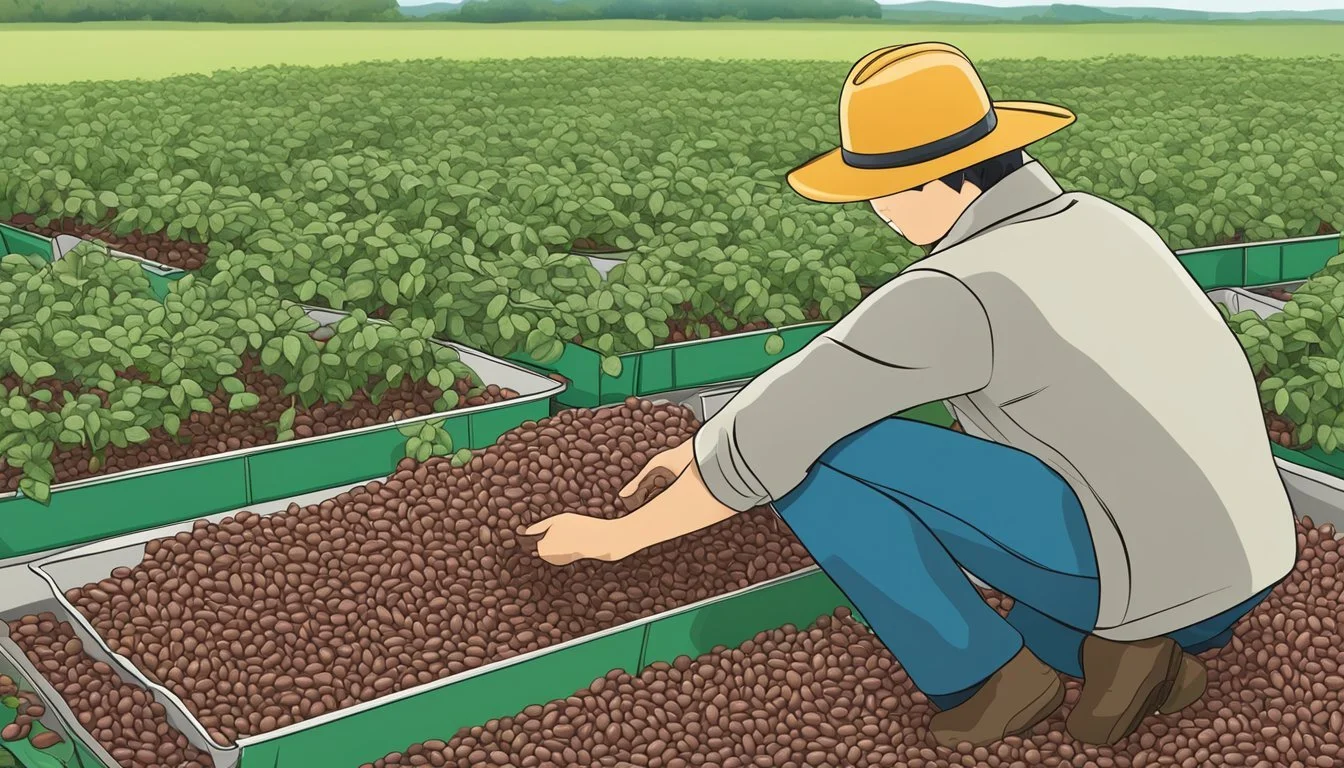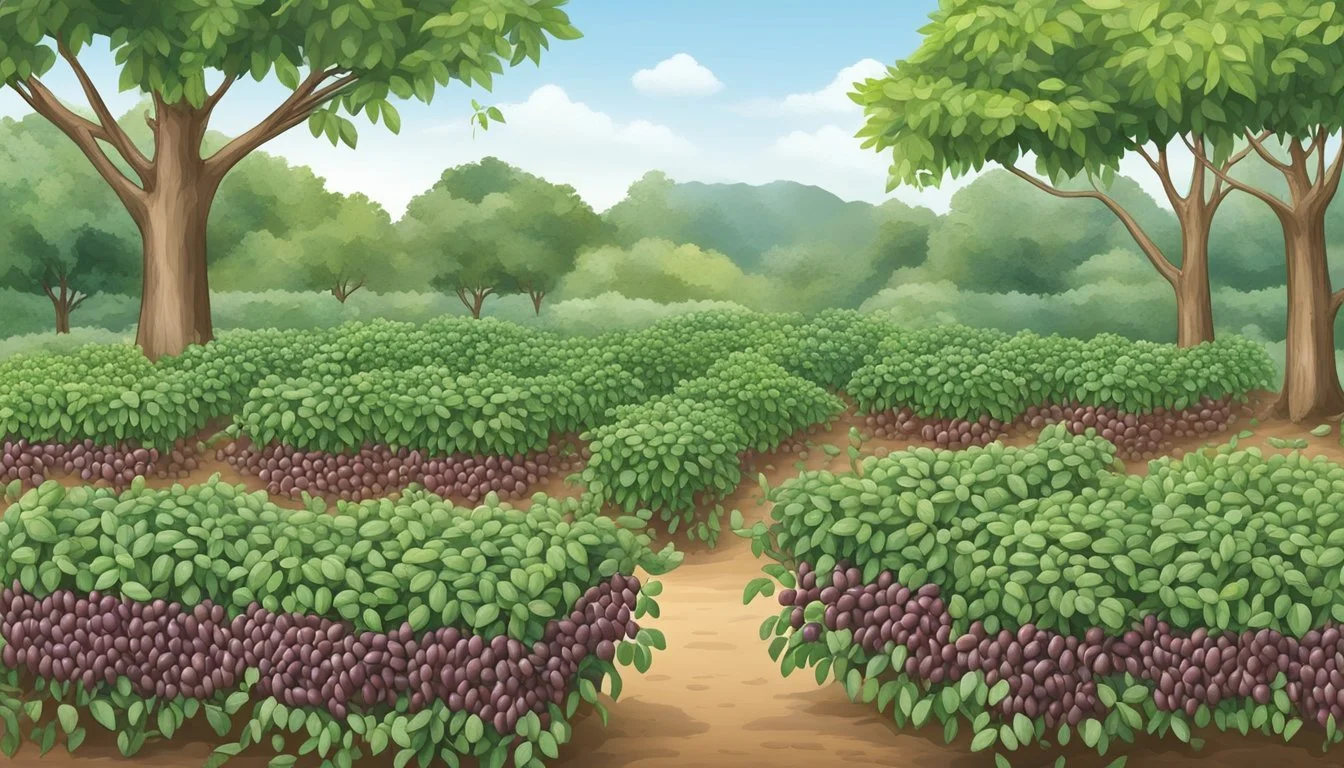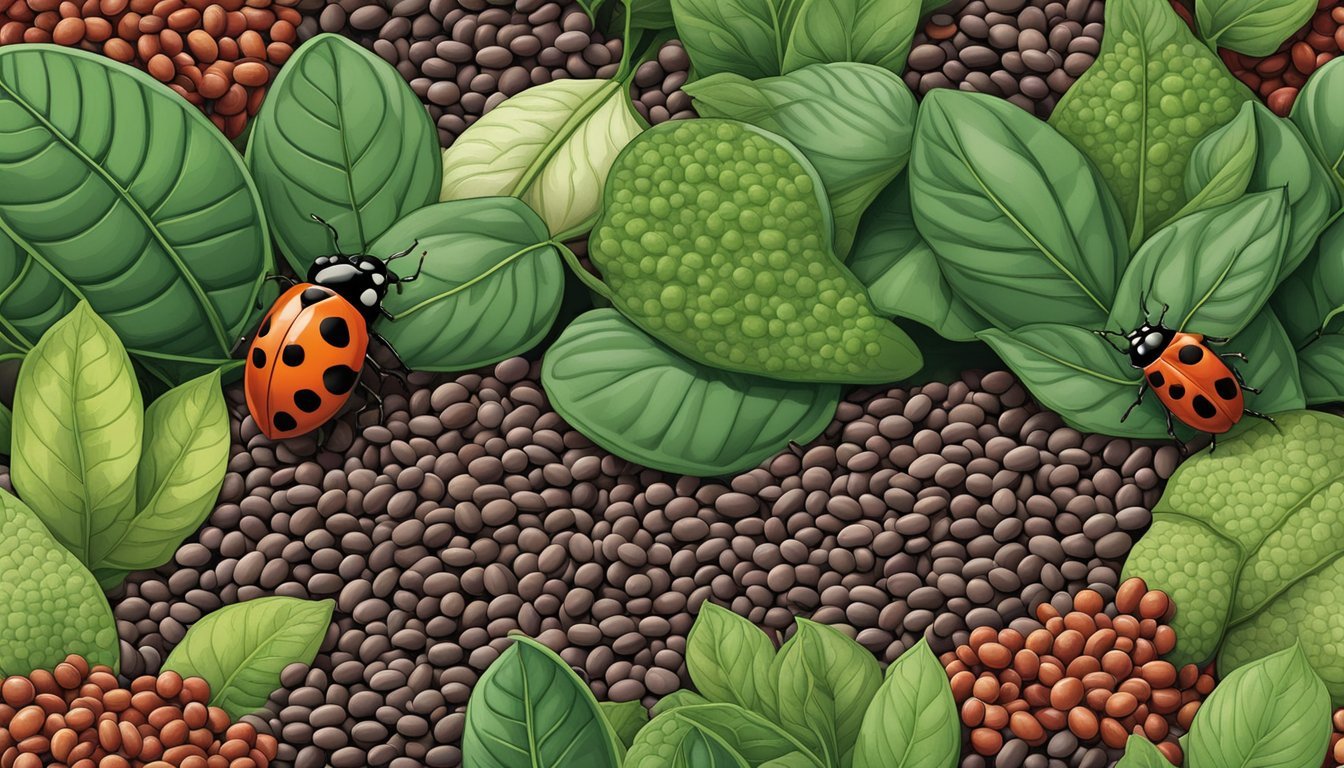Pest Control for Adzuki Beans
Effective Strategies for Crop Protection
Adzuki beans, known for their sweet flavor and commonly used in Asian cuisine, require careful attention to pest management for a successful harvest. These small, reddish-brown legumes are not only a valuable crop in terms of nutrition but also economically, particularly in markets that prize specialty beans. To maintain their health and productivity, it is essential to adopt effective strategies for pest and disease control. Proactive management is key to preventing infestation and the spread of diseases that can severely affect adzuki bean crops.
Particular challenges in cultivating adzuki beans include their vulnerability to pests, such as the bean cutworm and mirids, which can result in pod abortion and reduced yield. Since adzuki beans have slow early growth, they compete poorly with weeds, necessitating a combination of cultivation practices and potential chemical interventions. Understanding the life cycle of common pests and implementing integrated pest management approaches can help in minimizing the reliance on insecticides and reducing potential harm to the environment.
It's also imperative to consider the timing and method of interventions. For example, researchers stress the importance of addressing insecticide management when the pests are in their early stages, such as eggs or newly hatched caterpillars, to prevent larger infestations later on. Additionally, knowledge of effective weed management practices is crucial since early-season weed control plays a significant role in establishing a robust adzuki bean crop. Sustainable practices and precise application of pest control measures ensure both the protection of adzuki bean crops and the safe guardianship of the agricultural ecosystem.
Understanding Adzuki Beans
The adzuki bean, a staple in East Asian cuisine, is valued both for its culinary versatility and nutritional benefits. Originating from Asia, it has now found its way into global agriculture and kitchens.
Origins and Significance
The adzuki bean (Vigna angularis) hails from Japan and other East Asian countries, where it is integral to both culture and diet. Historically, this small bean has played a major role in regional festivals and remains a popular ingredient in Asian sweets and desserts.
Botanical Profile
Botanically known as Vigna angularis, the adzuki bean plant is characterized by its bushy stems, trifoliate leaves, and red or white flowers that develop into pods. These pods house the beans, which are small, with a distinctive reddish-brown hue.
Nutritional Value
Adzuki beans are a powerhouse of nutrition, offering a high protein content, fiber, and essential minerals. They serve as a good energy source, with a balance of carbohydrates alongside notable amounts of iron and potassium.
Global Cultivation
While native to Asia, adzuki bean production has extended to North America and other regions, aiming to meet the increasing demand. Its adaptability to different climates contributes to its successful yield beyond its traditional growing areas.
Adzuki Beans in Cuisine
In culinary contexts, adzuki beans often accompany rice dishes or are mashed to make red bean paste for confections. They are also used to make soups, flour, and a variety of sprouted bean dishes, demonstrating their versatility beyond traditional Asian desserts. While similar in use to kidney beans, adzuki beans have a sweeter taste and smoother texture, making them stand out in both savory and sweet applications.
Pre-Planting Considerations
Effective pre-planting strategies are crucial for successful cultivation of adzuki beans. Attention to soil health, seed selection, planting schedules, and early pest management sets the foundation for a productive harvest.
Soil Preparation
Preparing the soil begins with testing for pH levels and ensuring they are between 5.5 and 7.0 to optimize adzuki bean growth. Soil should be well-drained yet capable of retaining adequate organic matter and nutrients. Incorporating organic matter can improve soil structure and fertility. Tilling the soil helps eliminate overwintering insects and weeds, and ensures proper mix of nutrients and organic matter.
Seed Selection and Quality
Select high-quality adzuki bean seeds with a germination rate of at least 85% to ensure a uniform stand. Seeds should be free from visible damage or disease symptoms. Ensuring seed quality affects not only germination but also the plant's ability to resist pests and diseases.
Planting Time and Spacing
Your adzuki beans should be planted after the last frost to prevent cold damage. These legumes require a full sun location to thrive.
Spacing: Sow seeds approximately 2 to 4 inches apart in rows that are 18 to 30 inches apart to allow sufficient room for growth and air circulation, important in disease prevention.
Initial Care and Requirements
Early care of adzuki beans involves ensuring soil temperature is above 15°C (60°F) at planting for optimal germination. Regular watering is essential but avoid overwatering which can lead to root rot. Apply a low-nitrogen fertilizer if necessary, as high nitrogen can decrease flowering and pod development.
Pest and Disease Prevention Strategies
Implement cultural practices that discourage pests and disease:
Rotate crops each year to interrupt pest and disease life cycles.
Use certified disease-free seeds and resistant varieties when available.
Establish early weed control to prevent competition and minimize habitat for pests.
Consider a proactive approach by using appropriate pre-emergent herbicides, as noted in Weed control strategies in adzuki beans.
These pre-planting considerations, when carefully executed, help in raising a robust crop of adzuki beans that is less vulnerable to the challenges of pests and diseases.
Pest Control Methods
Effective pest management in adzuki beans involves the careful identification of pests and the strategic use of biological, chemical, and cultural tactics to maintain a healthy crop. Stay vigilant against common pests like aphids, loopers, and spider mites through varied control strategies and monitoring methods that focus on sustainable practices.
Identifying Common Pests
Adzuki bean crops may be afflicted by various pests, including aphids, beetles, thrips, caterpillars, spider mites, and loopers. Early and accurate identification is crucial to deploying the right control methods. For instance, soybean crops often face challenges with loopers, whereas adzuki beans might be more susceptible to aphids.
Biological Control Options
Biological controls leverage natural predators such as lady beetles and parasitic wasps to manage pest populations. These predators can naturally reduce the numbers of aphids and other harmful insects. Bacillus thuringiensis (Bt) is also an effective biological pesticide against caterpillars without impacting non-target species.
Chemical Control Tactics
Chemical pesticides offer a more direct approach but necessitate careful use to prevent resistance. Targeted application of pesticides at critical times can mitigate damage from beetles and caterpillars. Products containing neem oil and sulfur can be used against pests while posing fewer risks to beneficial insects.
Cultural Practices
Implementing cultural practices—like crop rotation, weed control, and maintenance of organic matter—is a cornerstone of pest management. Crop rotation interrupts pest life cycles, while removing weeds limits pest habitats. Tilling the soil can destroy overwintering insects and their larvae.
Organic and Home Garden Solutions
For organic and home gardens, a strong jet of water can dislodge aphids and spider mites. Neem oil and soap-based sprays can control beetles, mites, and flying insects if other methods prove insufficient. These solutions are especially important for home gardeners who aim to minimize chemical use.
Pest Monitoring and Thresholds
Regular monitoring is key to managing adzuki bean pests. Establishing pest thresholds informs decisions on when to implement control measures to avoid unnecessary interventions. Visual inspections and pest traps can aid in detecting early infestations, allowing for timely and effective control.
Optimizing Growth and Yield
To maximize the growth and yield of adzuki beans, it is crucial to manage various agronomic factors carefully. Among those are water and nutrient management, as well as controlling the growth environment, including soil temperature and protection against diseases.
Water Management
The soil for adzuki beans should remain evenly moist for optimal growth. Regular irrigation ensures that the soil moisture is adequate without causing waterlogging, which can lead to detrimental issues, such as root rot. Effective drainage is also essential to prevent excess water retention in the soil.
Nutrition and Fertilization
Fertilization is pivotal to supply nutrients that adzuki beans require for robust growth and high yields. An adequate supply of potassium and other essential nutrients is necessary to avoid nutrient deficiencies. The use of a balanced fertilizer can provide these nutrients in the required proportions.
Sunlight and Temperature Control
Adzuki beans thrive in full sun with a soil temperature range between 50°F and 90°F, with the optimum growth between 64-73°F. Protecting the crops from low temperatures and frost is important as they can significantly impede plant development.
Disease Management
The health of adzuki beans can be compromised by diseases such as anthracnose, bacterial blight, brown spot, rust, and mosaic virus. Employing proactive management practices can mitigate the impact of these diseases and help in maintaining a productive crop.
Harvesting and Post-Harvest
In the cultivation of adzuki beans, timely and proper harvesting alongside post-harvest practices are vital for maintaining the quality of the beans and ensuring their value in the market.
Harvesting Techniques
Adzuki beans reach maturity 90 to 120 days after planting, which is the ideal time for harvesting. It is crucial for farmers to monitor the color and dryness of the pods, as the pods should typically be brown and brittle when harvested. To maintain the quality of the beans, the harvesting should be done manually, minimizing damage to the plants and beans. For detailed instructions on the harvesting process, Agrownet provides comprehensive guidelines.
Processing and Storage
Once harvested, drying is the next critical step which prevents the growth of mold and preserves the bean’s flavor. Beans must be thoroughly dried before storage, which involves even spacing on drying racks or using dryers for larger operations. For long-term storage, beans should be kept in a cool, dry place away from direct sunlight to retain their quality and yield optimal returns. The UCANR publication helps explain integrated pest management in postharvest storage.
Marketing and Economics
The market demand for adzuki beans largely dictates the economics behind their production and sale. High-quality beans that have been properly harvested and stored fetch a better price. It is essential for farmers to understand the supply chain, seasonal prices, and international demand to optimize their economic returns. The value of adzuki beans can be influenced by their appearance, so maintaining quality through proper post-harvest handling is critical. The post-harvest management of pests, discussed in detail by a study on NCBI, is also a significant factor affecting the economics of adzuki bean farming.
Environmental Impact and Sustainability
The cultivation of adzuki beans intersects significantly with environmental sustainability and biodiversity. It requires an understanding of the appropriate sustainable farming practices, the potential impacts on biodiversity, and the ramifications of climate change on bean production.
Sustainable Farming Practices
In the context of adzuki beans, sustainable farming practices involve the strategic use of crop rotation to maintain soil fertility and reduce pest populations. By alternating adzuki beans with other crops, farmers enrich the soil with varied organic matter, enhancing its structure and nutrient content. Crop rotation also imparts greater resistance and tolerance to pest invasions, reducing dependency on synthetic chemicals for pest control.
Impact on Biodiversity
Biodiversity is crucial for the health of agricultural ecosystems. The cultivation of adzuki beans can positively impact local fauna and flora when integrated with pest management strategies that favor biological controls. By fostering an environment that supports natural pest predators, these practices help preserve the balance of ecosystems, limiting the harm to non-target species.
Climate Considerations
Climate change poses significant challenges to adzuki bean cultivation. Extreme weather events, including frost and intense cold, can damage crops and affect yield. Consequently, the development of adzuki bean varieties with improved tolerance to these conditions is a priority for researchers. Sustainable agricultural practices must adapt to climate considerations to ensure the resilience of adzuki bean production in the face of environmental shifts.
Looking Ahead
As we envision the future of adzuki bean cultivation, it is crucial to understand how emerging technology and research can intersect with sustainability and the adaptive measures required for crop improvement in response to climate change and evolving market demands.
Future of Adzuki Bean Cultivation
The path forward for adzuki bean farming is likely to be heavily influenced by technological advancements. Precision agriculture techniques are set to play a pivotal role in enhancing yield and efficiency. Breakthroughs in crop genetics provide the opportunity for developing resistant varieties that can withstand environmental stresses. On the horizon, innovations such as drought-tolerant cultivars and biotechnology applications present significant potential for yield stability and sustainability in adzuki bean production.
Research is key to these advances, with studies focusing on genomic sequencing of adzuki beans paving the way for genetic improvements. Integration of smart farming tools, including remote sensing and AI-powered analytics, will support farmers in making informed decisions, optimizing resource use, and reducing waste.
Challenges and Opportunities
The cultivation landscape for adzuki beans faces both trials and prospects:
Challenges:
Climate change impacts that may affect growing conditions and pest dynamics.
Economic vulnerabilities in response to market demands and price fluctuations.
Resource limitations, particularly in water-scarce regions.
Opportunities:
Research into sustainable farming practices empowers farmers to adapt to climatic shifts.
Population growth and health trends are increasing demand for nutrient-rich legumes like adzuki beans, expanding market opportunities.
Cross-disciplinary collaborations that harness technology for crop improvement efforts.
Continued investment in research and development is vital to navigate these challenges and capitalize on opportunities, ensuring that adzuki bean cultivation remains viable and productive in the years ahead.
Frequently Asked Questions
In addressing the concerns of adzuki bean farmers, the following frequently asked questions pinpoint the steps to protect these valuable crops from various pests and diseases, ensuring a healthy harvest.
What are common insect pests that attack adzuki beans?
Adzuki beans can fall victim to several insect pests, including the Mexican bean beetle and the bean leaf beetle. These pests can cause significant damage to the plants if not properly managed.
How can I protect adzuki bean crops from fungal diseases?
To safeguard adzuki bean crops from fungal diseases, it is essential to practice crop rotation and ensure proper air circulation around the plants. The use of fungicides may also be necessary in regions prone to fungal issues.
Which organic methods are effective for adzuki bean pest control?
Organic pest control for adzuki beans often includes introducing beneficial insects that prey on pests, cultivating pest-resistant varieties, and applying organic pesticides like neem oil to mitigate damage without harmful chemicals.
What are some signs of pest infestation in adzuki bean plants?
Signs of pest infestation in adzuki bean plants include holes in the leaves, defoliation, and the presence of the pests themselves on the plants. Vigilance in checking for these signs is crucial for timely pest management.
How often should adzuki bean plants be inspected for pests?
Adzuki bean plants should be regularly inspected for pests, preferably every week, to catch and address any infestations early. During peak growing seasons, more frequent inspections may be necessary.
What treatments are safe to use on adzuki beans for pest management?
Safe treatments for pest management on adzuki beans include the use of approved insecticides and adopting integrated pest management (IPM) strategies. Always consult product labels and local agricultural guidelines to ensure treatments are safe and effective.









